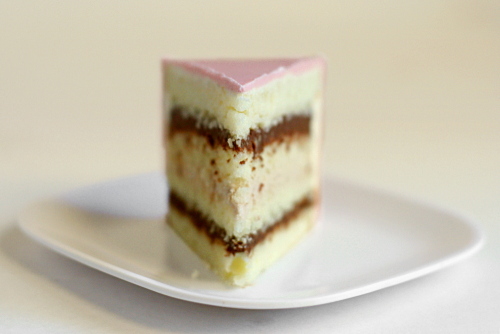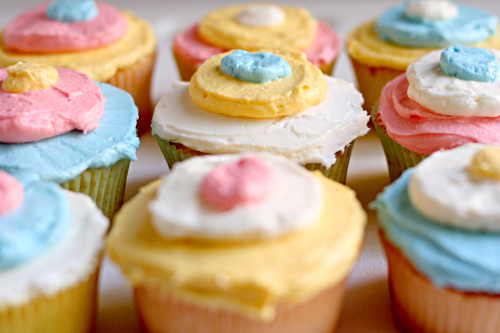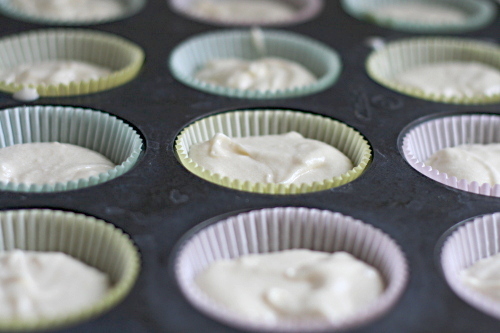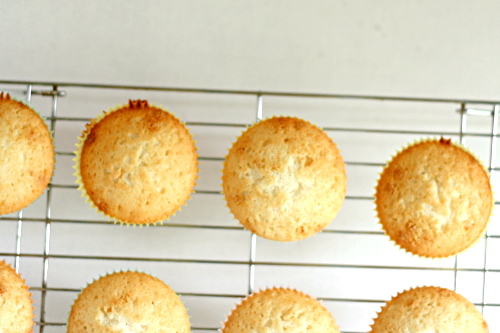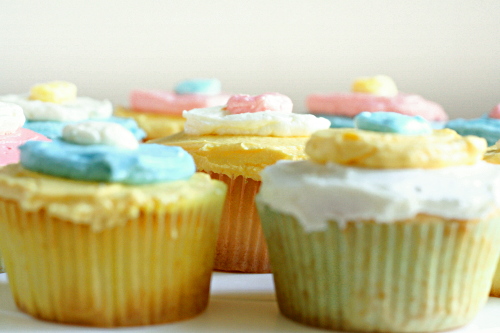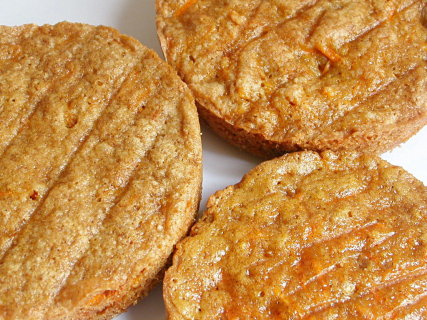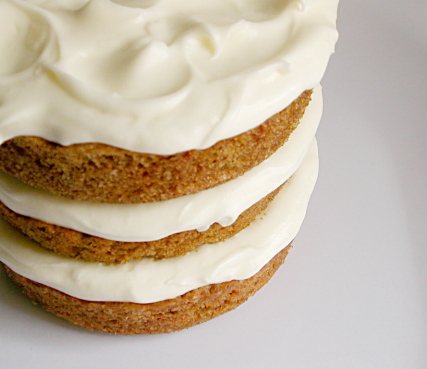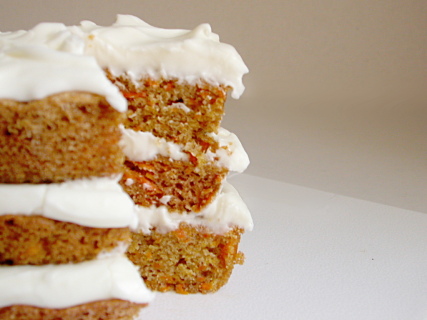I thought long and hard about what to make for my birthday cake. The thing about this obsessed-with-baking phase that I’m going through is that the eating of the cake is almost secondary to the fun of making it. I had a fairly long list of desserts I was considering, split almost evenly between cheesecakes and somewhat-elaborate layer cakes. I settled on Dorie Greenspan’s Black and White Chocolate Cake because it seemed like a good balance between fancy and not so much work that I’d spend all day (the day before my birthday) baking. Or so I had hoped.
The cake consists of a straightforward buttermilk-vanilla cake, layered with chocolate pastry cream and vanilla cream. The chocolate pastry cream was easy and delicious, and the cake itself came together without any problems.
The white chocolate cream, unfortunately, was not so smooth (literally). This was one of the first TWD recipes, back when there were only a handful of members, so I had scanned a few of their entries and seen that the white chocolate cream might be a problem. I knew enough to use high quality white chocolate, which is less prone to problems in baking than cheaper versions. Valrhona and Guittard are recommended most often, but both require a special, out-of-my-way trip to either Whole Foods or Williams-Sonoma, and I’ve had good experiences with Green and Black’s White Chocolate, which is available at my regular grocery store.
The white chocolate cream is made by melting white chocolate with cream, then adding that mixture to cream that’s been whipped to very soft peaks and continuing to beat until firm peaks are achieved. Firm peaks. Not stiff peaks. I guess I should have considered the difference between those two more carefully. I knew, knew, that there was the potential to overbeat the mixture and cause curdling, and I was so careful, only beating for about a second at a time, then checking the consistency. I was waiting until the peaks could hold their shape.
But the mixture curdled first. I tried to save it, the same way I’ve saved curdled buttercream in the past, and I thought for a while that it might work, but it didn’t. I kicked myself over and over for not stopping whipping the cream mixture early enough. Then I mentally berated Dorie for not being more specific. She gives such wonderful detailed instructions sometimes, describing exactly what the food processor should sound like when tart dough is ready, but she can’t add a warning about this “firm peaks” issue. Bleah.
Even if I’d had the right ingredients, which I didn’t, I wasn’t enthusiastic about trying the white chocolate cream again. Instead, I made a white chocolate buttercream. But I accidentally only made enough to give the cake the thinnest of coatings. I was tired of dealing with fussy white chocolate, and I’d already incorporated raspberries into the cake, so then I made another buttercream, this time flavored with raspberries. But I was frustrated and bored by this time, so I screwed up the buttercream, twice (cooked the egg whites), because of I was inattentive.
So much for my relatively straightforward cake. To assemble, I mixed a portion of the white chocolate buttercream with some raspberry pastry cream I had leftover from another project, and used that as the white chocolate layer in the cake. I used the white chocolate buttercream as a crumb coat and the raspberry buttercream as a final layer.
I wasn’t disappointed in the final product. For one thing, it was really pretty. The cake itself was tasty, although it probably could have used a quick brush with a simple syrup. The dark chocolate pastry cream was fantastic. I wasn’t totally happy with either the white chocolate or the raspberry buttercream, but neither detracted from the final product, even if they didn’t add much. All in all, a satisfactory birthday cake.
Black and White Chocolate Cake (from Dorie Greenspan’s Baking: From My Home to Yours)
Makes 10 servings
For the Cake
2 cups cake flour
2 teaspoons baking powder
⅛ teaspoon baking soda
¼ teaspoon salt
1¼ sticks (10 tablespoons) unsalted butter, at room temperature
1 cup sugar
3 large eggs
1 large egg yolk
1 teaspoon pure vanilla extract
¾ cup buttermilk
For the Dark Chocolate Cream
2 cups whole milk
4 large egg yolks
6 tablespoons sugar
3 tablespoons cornstarch, sifted
¼ teaspoon salt
7 ounces bittersweet chocolate, melted
2½ tablespoons unsalted butter, cut into 5 pieces, at room temperature
For the White Chocolate Whipped Cream
6 ounces premium-quality white chocolate (such as Valrhona Ivoire or Guittard), finely chopped
1½ cups heavy cream
Chocolate shavings or curls, dark or white or a combination, for decoration (optional)
Getting Ready:
Center a rack in the oven and preheat the oven to 350 degrees F. Butter two 9-x-2-inch round cake pans, dust the insides with flour, tap out the excess and line the bottoms of the pans with parchment or wax paper. Put the pans on a baking sheet.
To Make the Cake:
Sift together the cake flour, baking powder, baking soda, and salt.
Working with a stand mixer, preferably fitted with a paddle attachment, or with a hand mixer in a large bowl, beat the butter on medium speed until soft and creamy. Add the sugar and beat for another 3 minutes. Add the eggs one by one, and then the yolk, beating for 1 minute after each addition. Beat in the vanilla; don’t be concerned if the mixture looks curdled. Reduce the mixer speed to low and add the dry ingredients alternately with the buttermilk, adding the dry ingredients in 3 additions and the milk in 2 (begin and end with the dry ingredients); scrape down the sides of the bowl as needed and mix only until the ingredients disappear into the batter. Divide the batter evenly between the two pans and smooth the tops with a rubber spatula.
Bake for 28 to 30 minutes, rotating the pans at the midway point. When fully baked, the cakes will be golden and springy to the touch and a thin knife inserted into the centers will come out clean. Transfer the cakes to a rack and cool for about 5 minutes, then unmold, remove the paper and invert to cool to room temperature right side up on the rack.
To Make the Dark Chocolate Cream:
Bring the milk to a boil.
Meanwhile, in a large heavy-bottomed saucepan, whisk the egg yolks with the sugar, cornstarch and salt until thick and well blended. Whisking without stopping, drizzle in about ¼ cup of the hot milk – this will temper, or warm, the yolks so they won’t curdle – then, still whisking, add the remainder of the milk in a steady stream. Put the pan over medium heat and, whisking vigorously, constantly and thoroughly (make sure to get into the edges of the pan), bring the mixture to a boil. Keep at a boil, still whisking, for 1 to 2 minutes. Remove the pan from the heat.
Whisk in the melted chocolate, and let stand for 5 minutes. Then whisk in the pieces of butter, stirring until they are fully incorporated and the chocolate cream is smooth and silky. Press a piece of plastic wrap against the surface of the cream to create an airtight seal and refrigerate the cream until chilled, or for up to 3 days. Or, if you want to cool the cream quickly, put the bowl with the cream into a large bowl filled with ice cubes and cold water and stir the cream occasionally until it is thoroughly chilled, about 20 minutes.
To Make the White Chocolate Whipped Cream:
Put the white chocolate in a heatproof bowl and put the bowl over a saucepan of gently simmering water. Stir frequently to melt the chocolate evenly. Meanwhile, bring ½ cup of the heavy cream to a boil.
When the white chocolate is melted, remove the bowl from the pan. Pour the hot cream into the melted chocolate and let it sit for a minute. Using a small spatula, stir the chocolate gently until it is smooth. Let it sit on the counter until it reaches room temperature – it can’t be the least bit warm when you add it to the whipped cream.
Working with the stand mixer with the whisk attachment or with a hand mixer in a large bowl, beat the remaining 1 cup heavy cream only until it holds the softest peaks. Turn the machine to high, add the cooled white chocolate all at once and continue to beat until the whipped cream holds firm peaks. Turn the whipped cream into a bowl, press a piece of plastic wrap gently against the surface to create an airtight seal and refrigerate for at least 2 hours, or up to 6 hours.
To Assemble the Cake:
If the tops of the cake layers have crowned, use a long serrated knife and a gentle sawing motion to even them. Slice each layer horizontally in half. Place one layer cut side down on a cardboard cake round or on a cake plate protected by strips of wax or parchment paper.
Remove the dark and white chocolate creams from the refrigerator and whisk each of them vigorously to loosen and smooth them. With a long metal icing spatula, spread enough dark chocolate cream (about 1 cup) over the cake layer to cover it completely. Top the cream with another cake layer, cut side up, and cover this layer with white chocolate whipped cream, making the white layer about the same thickness as the dark layer. Cover with a third layer, cut side up, and cover with another cup or so of the dark chocolate cream. (You’ll have some dark chocolate cream left over – use it as a dip for madeleines or sables.) Top with the final layer of cake, cut side down, and frost the sides and top with the remaining white chocolate whipped cream. If you’d like to decorate the top with chocolate shavings or curls, do it now.
Refrigerate for at least 3 hours, or overnight.
Serving: Remove the cake from the fridge about 20 minutes before serving. Use a serrated knife and a gentle sawing motion to cut it. Though the cake is particularly good with coffee or tea, it also goes well with a sweet or sparkling dessert wine.
Storing: While both the dark chocolate cream and white chocolate cream can be made ahead and kept tightly covered in the refrigerator, once assembled, the cake is best after about 3 hours in the fridge. However, it can be refrigerated overnight – just cover it loosely and keep it away from foods with strong odors.
The Raspberry Buttercream is the same recipe used for Dorie’s Perfect Party Cake, with raspberry puree substituting for the lemon juice. The White Chocolate Buttercream is the ingredients in this recipe using the method for Dorie’s buttercream.









